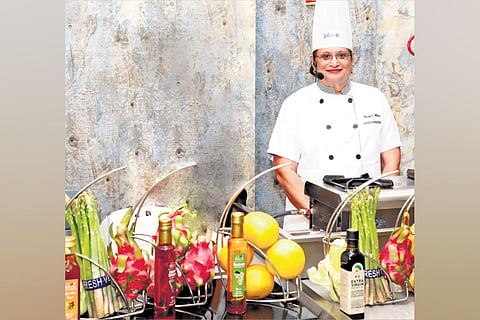

BENGALURU: Once upon a time, before the region became the title of the popular movie franchise, Kolar Gold Fields (KGF) was where several Germans, Scottish, French and Dutch people worked. It was a hub for Anglo-Indians too. Their lifestyle, including the cuisine, changed and gave rise to Anglo-Indian cuisine. Growing up among them was Bridget White Kumar. The Bengaluru chef and author is a preserver of the food and culture of this community.
Preserved in pages
Kumar has penned nine books to date, publishing her first book, Anglo-Indian Cuisine A Legacy of Flavours from the Past, in 2004. Recalling the daunting task, she says, “I sent a whole manuscript of 500 recipes to many publishers in Delhi, but they were not receptive. They said that this may not sell. And that they did not know that such a community exists.” She then raised this concern to the-then president of Anglo-Indian Association, and they volunteered to launch the book.
“The publisher told me not to bring out all 500 recipes in one shot. But a few recipes from each section,” she says. A booklet was released and the recipes were divided into three editions. This got her the Gourmand Cook Book Award in 2012. “It was judged as the best culinary history book from India and the feeling was thrilling,” shares Kumar.
Similar is the story of her latest release, Nostalgic Anglo-Indian Comfort Food, which was judged fourth fourth-best cookbook in the world in 2023 under the Digital category, and nominated by Amazon Kindle. In this book, Kumar brings recipes interspersed with her childhood memories of growing up in KGF. One among them is when the vendor of naatu kozhi mutta visited. “Whenever this elderly man came, the kids were excited. We brought a big bowl of water and the eggs were put in it one after another. If the eggs sank to the bottom, they were good, and if they floated on top, he had to remove them, he would be so disappointed because it was a loss for him,” she recalls.
A cuisine apart
As her career as an author soared, Kumar was approached by renowned hotels and restaurants to teach their chefs.
Kumar points out that there are two streams of this cuisine. One came about during the time of the British Raj and the other was innovated by bawarchis. “We embrace the European rolls and cutlets and are also fond of rice and curry. Anglo-Indian food is comfort food, neither too spicy nor too heavy, but simple and tasty,” she says.
The cuisine has a subtle taste, with its unique flavours and judicious use of spices that are not compromised on. Not every spice is used in every dish, and nothing is used in excess but in the right amount. “If you are using two teaspoons of chilli powder in your curry, we would use maybe a three-quarter to one teaspoon only,” says Kumar, explaining what makes this cuisine stand apart.
Kumar believes that every cuisine should be preserved because the food that is cooked today is itself a fusion. The authenticity of most of the traditional food is being lost, she says. “If not, there will come a time when you will be searching for food that was cooked in your home that is not available,” she signs off.
ANGLO-INDIAN PEPPER CHICKEN
(A timeless dish of chicken either boneless or on the bone, simmered in a pepper sauce and sautéed with sliced onions and slit green chillies)
Ingredients
Chicken cut into medium size pieces: 1 kg
Onions (Large, sliced finely): 3
Green chillies (Slit lengthwise): 2
Pepper powder: 2 tsp
Turmeric powder: 1 tsp
Oil: 2 tsp, Salt to taste
Method
Heat oil in a pan and fry the onions lightly.
Add the chicken and mix in the pepper powder, turmeric powder and salt. Fry till the pieces firm up.
Add ½ cup of water and cook on low heat till the chicken is tender and semi-dry. Simmer for 10 minutes, stirring occasionally till the chicken gets a shiny colour.
Alternatively, the chicken can be parboiled
with a little water and then added to the sautéed onions and pepper.
BRINJAL VINDALOO (AUBERGINE / EGGPLANT VINDALOO)
(The non-vegetarian version of vindaloo is usually made with pork or meat. The tangy, sweet, taste with a hint of spice is just the right combination with either steamed rice or any flavoured rice. It goes well with rotis, chapattis or bread too.)
Ingredients
Seedless brinjal (Large): 1
Onion (chopped finely): 2
Chilli powder: 2 tsp
Turmeric powder: ½ tsp
Ginger-garlic
paste: 2 tsp
Cumin powder: 1 tsp
Tomato juice/puree: ½ cup
Cinnamon: 2 pieces
Vinegar: 2 tbsp, Sugar: 1 tsp
Salt to taste, Oil: 3 tbsp
Potato (boiled and peeled and cut into quarters): 2
Method
Cut the brinjal into medium-sized pieces and soak in a bowl of water to which a pinch of salt has been added.
Heat oil in a pan and sauté the onions till golden brown. Add the ginger-garlic paste and cinnamon and fry for some time. Now, add the chilli powder, cumin powder, turmeric powder, sugar and tomato puree and fry till the oil separates from the mixture.
Add the cut brinjal, vinegar and a little water and simmer till the gravy is sufficiently thick and the brinjal is cooked. Do not overcook the brinjal.
Add in the boiled potatoes and mix gently. Let it rest for 15 minutes so that the potatoes draw in the flavour.
Garnish with 2 slit green chillies only (No coriander leaves to garnish)
Serve with rice or chapatti.